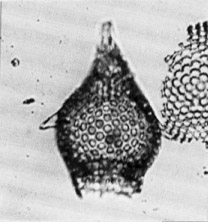 Lamptonium
pennatum Foreman
Lamptonium
pennatum Foreman Lamptonium
pennatum Foreman
Lamptonium
pennatum ForemanLamptonium pennatum Foreman, 1973, p.436, pl.6, figs.3-5, pl.11, fig.13
Cephalis subhemispherical, with a few circular pores and pore-shaped depressions, and bearing a sturdy bladed horn. Collar stricture with six collar pores internally, not expressed externally, contour of cephalis merging with that of inflated thorax. Thoracic pores circular to subcircular, occasionally uneven or with prongs on their margin, generally regularly quincuncially arranged in longitudinal rows; surface roughened with pointed nodes. Three three-bladed wings extend outwards from the median thorax. Abdomen subcyclindrical, fragile, lamellar, with circular to elliptical pores; termination ragged (Foreman, 1973).
Based on 20 specimens. Length of cephalis and thorax, excluding horn 125-150 µm; greatest width of thorax 100-140 µm, width of proximal abdomen 68-80 µm (Foreman, 1973).
Length excluding horn 140-215 µm; of cephalothorax 115-160 µm; maximum breadth 100-155 µm (Sanfilippo et al., 1985).
L. pennatum differs from L. f. fabaeforme by the presence of wings, from L.(?) colymbus Foreman (1973) by possessing a third segment, being smaller in size, and having the wings more distally placed on the thorax (Sanfilippo et al., 1985).
The collar stricture is not expressed externally, so that the cephalis merges with the inflated thorax. The horn varies in degree of development, but is usually sturdy and bladed. The thoracic pores, generally in longitudinal rows, vary somewhat in size, as does the length of the three-bladed wings originating from the median thorax. The thoracic surface is roughened by small thorns. The small abdomen is very fragile, with circular to elongate pores and a ragged termination. Very rare early forms have been observed to have a closed, inverted cap-like abdomen (Sanfilippo et al., 1985).
Lamptonium pennatum is found in Paleocene to earliest Eocene assemblages from the tropical Indian and Pacific Oceans, from the Caribbean and the Gulf of Mexico. Its morphotypic first appearance is below the oldest defined Paleocene zone, the Bekoma campechensis Zone. It evolved into Lamptonium fabaeforme fabaeforme within the Bekoma bidartensis Zone.
L. pennatum is the precursor of L. f. fabaeforme. Its own ancestor is not known. However, intermediate forms have been observed in one Indian Ocean sample (DSDP 237-41-1) appearing to link Sethochytris babylonis (Clark and Campbell, 1942) to the Lamptonium lineage. The forms transitional to Sethochytris babylonis have a smaller thorax (length of cephalothorax 90-120 µm; maximum breadth 90-100 µm) than Lamptonium pennatum occurring in the same sample (length of cephalothorax 125-140 µm; maximum breadth 110-130 µm). The transitional forms show remnants of a very delicate third segment, and the three feet originating from the distal portion of the thorax in Sethochytris babylonis here extend outward from the median thorax (Sanfilippo et al., 1985).